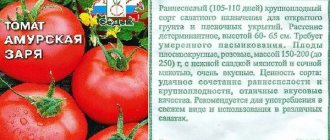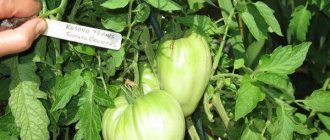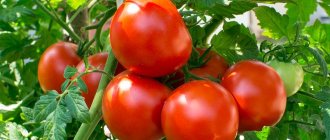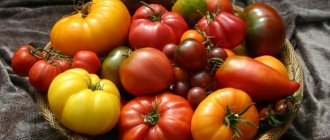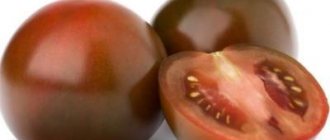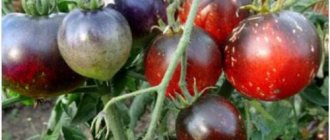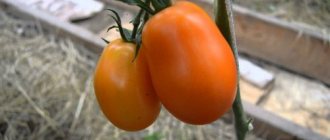The Cossack tomato bears fruit consistently and for a long time, the fruits have an excellent taste, and it is not difficult to grow. Many gardeners who have already tried to cultivate them are very happy with tomatoes, eat them fresh, squeeze the juice and prepare all kinds of dishes.
| Height | Landing location | Ripening time | Fruit color | Fruit size | Origin | Fruit shape |
| Tall | Greenhouse | Mid-season | Reds | Average | Variety | Round |
Description and characteristics of the variety
Kazachka tomatoes are a new product from agro. Tomatoes are not suitable for growing in open ground, as their height reaches 1.9-2 m.
The variety is medium-late, the period from germination to the beginning of fruit ripening is 120-130 days.
The stem of the plant is weak, twisted, and needs to be tied to a trellis from the moment the seedlings are planted in the ground.
The foliage is large, light green, darkening with age. The clusters are long, in the form of braids, each bearing 9-13 fruits.
Kazachka tomatoes are interesting for their color, which, depending on the growing conditions, varies from dark cherry to terracotta (see photo).
Tomatoes have thin skin and juicy, sugary pulp. The presence of white veins is noticeable on the cut. The variety is primarily used for salad purposes; when canned, the delicate skin of the fruit may burst. The culture is perfect for making tomato juice.
On a note! The Cossack tomato is not a hybrid. The collected seeds can be used for planting next year.
Tomato Cossack characteristics and description of the variety, yield with photo
Description and characteristics of the Kazatsky tomato variety, reviews, photos
Kazachka tomatoes are medium-late ripening.
This variety is of indeterminate type; its bushes reach 1.9 m in height. The stems of the plant are flexible and climbing. Usually the bush is formed in such a way that it has no more than three trunks. The leaves at the beginning of the plant's life are light in color, but as they grow they become dark green. The leaf shape is normal. An average of 1.5 to 2.5 kilograms of fruit is harvested from one bush. Kazakhstan yellow tomato - description and characteristics of the variety
An early, determinate, very productive tomato variety for open ground.
The bush is up to 50 cm high and does not require pinching. A garter to the support is required, as otherwise the plant will fall under the weight of the tomatoes.
photo by Valentina Redko
The fruits are round, red in color at maturity, weighing 60-80 grams. The taste is good, real tomato. These tomatoes are good for both fresh consumption and for pickling and canning, and home cooking.
Super productive variety!
Description of fruits
The plant is tall, so “Kazachka” tomatoes are planted using the 50 x 50 cm technology. The period from seed germination to the ripening of the first tomato harvest is 120-125 days.
The description of the “Cossack” fruits is as follows: medium, round or slightly barrel-shaped, smooth, juicy. The color of the ripe fruit is dark, red-brown. The skin of this tomato variety is tender and thin. Tomato variety "Kazachka" has a good delicate taste and pleasant aroma.
They are consumed fresh and in salads. The fruits are often preserved in the form of tomato juice, since the very thin skin bursts when the whole fruit is preserved. Reviews for this variety are mostly positive. Those who have already planted tomatoes of this variety note the beautiful appearance of chocolate tomatoes on the bush.
The sizes of the fruits of the variety are not the same, from 35 to 50 grams. Productivity is about 1.5-2 kg per bush.
The fruits of Kazachka tomatoes are medium in size. They have a very beautiful red color, sometimes taking on a chocolate-brown or reddish-purple hue. The fruits are round in shape, but may be slightly barrel-shaped. Cossack tomatoes are smooth, highly juicy, and have delicate, thin skin. They have a very pleasant aroma and delicate taste.
The fruits are not universal in use. They are very good to eat raw and add to summer salads, but for canning they are only suitable in the form of tomato juice, since their thin peel bursts if they are canned whole.
Growing seedlings
For seedlings you will need special containers, this can be a wooden box, a plastic container, seedling cassettes and others that are convenient for the gardener, but before sowing they must be disinfected. There should be drainage holes at the bottom.
You will also need special soil for seedlings, or sand mixed with peat in equal quantities; it must be moistened before sowing.
The seeds also undergo treatment in order to disinfect them and improve sowing qualities, as well as reduce the time before emergence; they are heated at variable temperatures: for 48 hours at 30 degrees and another 72 hours at 50 degrees.
The planting should not be thickened, as this will cause the seedlings to stretch out. Before starting sowing work, the following conditions must be ensured:
- Suitable temperature.
- Lighting.
- Air circulation.
Before the first shoots, the temperature in the room where the container with the seeds is located should be approximately 23, after they appear it can be reduced to 15 during the day, 10 at night, this temperature regime must be maintained for up to 3 days. Afterwards, the optimal temperature for plants is 20 degrees. Frail sprouts should be watered using a sprayer; they should not be overfilled.
Also, before the seedlings are transferred to a permanent place, they are hardened off for 15 days, the first days they are taken out into the air for an hour, and the time spent outside is gradually increased. This is necessary so that the plants quickly adapt to the garden bed (in the greenhouse) and tolerate replanting more easily.
Views of summer residents
Tomatoes of the Kazachka variety have repeatedly been included in the list of the most popular tomatoes grown in greenhouses. Gardeners value it, first of all, for its unique aroma, thin peel, wonderful characteristic sweetish taste and very juicy pulp. Survey respondents emphasize the beauty of both the fruits and the bush of these tomatoes, good resistance to late blight, and a large number of tomatoes in one bunch.
The Kazachka variety is another successful work of Russian breeders. Tomatoes of this variety have an original pleasant taste and smell, and thin skin. The unusual elegant color and glossy shade give the fruits of this variety an attractive presentation. Kazachka tomatoes are excellent for both industrial cultivation and individual farms.
June tomato - description and characteristics of the variety
Preparing the landing site
Considering that tomatoes love light and warmth, choose a sunny area. Bushes should not be planted after nightshade crops, as they have common diseases that can be transmitted to plants through the soil. The best precursors for tomatoes are cabbage, cucumbers and legumes.
The land is prepared in the fall, for this purpose it is fertilized with manure and dug up. This can be done in the spring, but no later than two weeks before planting the seedlings. Fertilizers are also added to the holes; wood ash is perfect. Up to 8 bushes can be placed on one square meter, the planting pattern is 30 by 70.
Tomato Summer resident
Sowing seeds and growing seedlings
The Cossack tomato is not particularly resistant to diseases. Soil and planting material must be disinfected. The soil for planting is spilled with a solution of Fitosporin or heated in an oven at 100˚C for half an hour.
The seeds are soaked in a solution of cherry potassium permanganate, then washed. To improve immunity, wet seeds can be placed in the refrigerator for a day.
Seeds for seedlings are planted 2 months before planting in the greenhouse. In the middle zone this is the end of February - beginning of March.
Sowing is carried out in shallow boxes to a depth of 1-1.5 cm, and the plantings are covered with film. Maintain air temperature +20-22˚С.
When the seedlings sprout, the box with seedlings is placed in the brightest but coolest place possible; young seedlings tend to stretch out. It’s a good idea to provide artificial lighting.
Seedlings dive in the phase of two true leaves into separate pots. Feed 2 times with special fertilizers for seedlings.
Two weeks before planting, the seedlings begin to harden. First, they open the window, then take it out onto the terrace or balcony. Seedlings in pots should spend the last few days in a greenhouse to make it easier to acclimatize.
Description
Belongs to mid-late varieties, the growing season lasts 120-125 days. Planting seedlings in a greenhouse is recommended. The bushes are indefinite and can be up to two meters in height. It has a climbing, very flexible stem and large foliage; when the plant is still young, its leaves are light green; over time, their color changes and they acquire a dark green color.
The fruits grow in long clusters, smooth, round or barrel-shaped. The tomatoes are dark cherry in color, the same as you choose, their weight ranges from 35 to 60 grams. The skin is thin, the pulp is juicy, multi-seeded and has a pleasant aroma typical of tomatoes. The yield is quite good; from one bush you can collect up to 2 kg of tasty fruits.
This variety rather belongs to salad tomatoes, as it is consumed mainly fresh. This variety is especially useful for men. Suitable for preparing tomato juice and various sauces. It is not recommended to preserve whole fruits, because the thin skin is susceptible to cracking.
Advantages
- Uniform ripening of fruits.
- Attractive presentation.
- Great taste.
- Good harvest.
- High rates of seed germination.
Flaws
- Demanding about garters and stepsoning.
- You cannot preserve whole fruits.
- The variety is not resistant to diseases.
Planting in the ground and caring for tomatoes
Depending on the weather, the Cossack tomato is planted in a greenhouse from the end of April to May 10. The soil temperature should warm up to 12-15˚C. On the eve of planting, the seedlings are watered abundantly and the cotyledon leaves are cut off.
Plants are planted in prepared holes according to the 50×50 pattern. For 1 sq. m you can plant no more than four bushes.
The seedlings are watered abundantly and tied to a trellis. After planting, tomatoes are kept without watering for 7-10 days to form an extensive root system.
The Kazachka variety needs pinching and bush formation. The plant needs to be formed into 2 stems, the second shoot is made from the strongest stepson.
During flowering, the bushes are sprayed with the preparations “Ovary”, “Bud”, and a 2% solution of boric acid. This procedure increases fruit set and improves their sugar content.
The Cossack tomato is responsive to fertilization. At the beginning of the growing season, the crop is fertilized with a solution of organic fertilizers or herbal infusion.
During the fruiting period, plants need mineral phosphorus-potassium fertilizers. In August, feeding continues, reducing the dose of nutrients.
Note! The variety is demanding on air humidity, it should be 65-70%.
Covering the soil with mulch solves several problems at once: it balances the microclimate in the greenhouse, retards the growth of weeds, and prevents the development of fungal diseases. Daily ventilation of the greenhouse is useful.
Water the tomatoes rarely, but generously, avoiding the stream of liquid getting on the trunk and leaves of the plant. One bush needs 7-10 liters of warm, settled water. In August, watering is sharply reduced.
Features of cultivation and care
The Cossack tomato is bred by planting seedlings and then transplanting them into greenhouse soil. Seeds are planted in the ground 60-65 days before the intended planting in the soil. The variety is not particularly resistant to common diseases of nightshade fruits, so the seeds are treated with special solutions against fungi and pests, which are sold in stores for this purpose. The soil must also be disinfected before planting; this is done using a hot solution of potassium permanganate. Seeds for seedlings are planted in grooves made in the soil (it must certainly be with the addition of calcined sand). Plant to a depth of no more than 15 mm.
Fertilizing is applied repeatedly. First, seedlings are fed immediately after the appearance of 1 leaf. Then, by adding fertilizers to the soil, the plants are nourished after picking. It is necessary if the seedlings were planted in large containers. Some experts recommend fertilizing 2-3 times with special fertilizers or growth stimulants.
After transplanting into the soil, the plant must be fed during the period of flowering and ovary of tomatoes. When flowers appear, the humidity in the greenhouse should not exceed 65%, otherwise cross-pollination will not occur on the bushes.
To garter bushes, it is better to use the trellis method of arranging the stem and brushes with tomatoes so that the bushes are not damaged by the weight of the fruit.
Diseases and pests
The Kazachka variety has moderate resistance to tomato diseases.
Main fungal and bacterial diseases:
- Phytophthora on tomatoes - appears at the end of summer after cold nights, leaves and fruits are affected. Often has a lightning-fast course. Without taking measures, you can lose your harvest.
- Brown spot is a fungal disease that affects foliage and causes the ovaries to fall off. Reduces yield by a third.
- Alternaria - pathogenic microflora is activated in cold weather and high humidity. The plant dies, losses can reach 65%.
- Blossom rot is a physiological disease caused by negative environmental conditions. Affected fruits are not suitable for use.
For small foci of the disease, folk remedies are used. For extensive lesions, treatment with fungicides is required at least 14 days before harvest.
Preventive actions:
- thorough cleaning of plant residues from the beds in the fall;
- soil disinfection in the greenhouse;
- planting green manure after harvesting tomatoes;
- spraying young plants with a 1% solution of Bordeaux mixture at the beginning of the season.
Spraying plants with the biological preparation Fitosporin throughout the growing season will protect the crop from diseases, improve the soil structure and its fertility.
The main insect pests of nightshade crops are:
- whitefly;
- various types of aphids on tomatoes;
- Colorado beetle;
- spider mites on tomatoes.
A small number of parasites are caught using traps and sprayed with aqueous infusions of garlic, onion peels, and tobacco dust. To make the solution stick to the leaves, add diluted laundry or green soap.
In advanced cases, systemic and contact insecticides are used: Prestige, Aktara, Fufanon, Actellik.
On a note! The biological preparation Fitoverm is much less toxic; the condition for its effectiveness is treatment at a temperature of at least +18˚C.
Similar varieties
The Cossack tomato is a tomato containing the pigment anthocyanin and a high amount of lycopene. These organic substances have antioxidant properties, antitumor effects, and slow down the aging of the body. Unfortunately, black-fruited tomatoes rarely have high yields. The Cossack tomato is one of the pleasant exceptions.
Similar varieties according to characteristics and descriptions:
- Black truffle is a mid-early cultivar, plant height 1.5-2 m, pear-shaped fruits 120-150 g;
- De Barao black - medium late tomato, height 2.4-3 m, round fruits 40-70 g;
- Kumato is a mid-late variety, 2 m tall, fruits 60-80 g.
Advantages and disadvantages of the variety
The Cossack tomato combines the taste of red fruits and the beneficial properties of black-fruited varieties.
Positive qualities of tomatoes:
- pleasant taste and aroma, thin skin;
- increased content of valuable vitamins and microelements;
- attractive color of ripe fruit;
- good set, high yield;
- extended fruiting.
Flaws:
- long ripening;
- when harvested in the technical ripeness phase, sugar content is lost;
- the variety does not tolerate changes in temperature and humidity;
- short shelf life of tomatoes.
The variety is considered one of the best for growing in greenhouse conditions in central Russia.
Reviews from gardeners
“I’ve been growing this variety for several years now and for the last two years I’ve been very pleased with the results. The tomatoes are very tasty, and there are no problems with growing them. You just need to feed it on time and don’t forget to water it. I came up with everything on my own, because there were no clear instructions anywhere. And thank you very much to the creators of the variety. »
“Delicious variety and the tomatoes are simply fabulous. But for preservation they are only suitable in salads. You can make juice. Very thin skin, perfect for eating. But I made pickled ones for canning, and some of the skins burst. But the harvest was excellent - the whole family ate it, and it was fresh every day.”
Ivan Markovich, 61 years old. Volgograd:
“To have a good harvest, you need to constantly feed. It's a delicate matter - I didn't guess right, there was no harvest. If you gave too much, you ruined the plant. The variety is delicious, I can’t say anything. And here you also need to maintain the correct humidity. Too much water - the plants get sick, too little - they are not pollinated. I looked on the Internet for the exact proportions of fertilizers - it wasn’t written anywhere, so I did it at my own peril and risk. But my wife says that we need to plant again, because the harvest is good. I'm not sure, I'll think about it. There are less troublesome varieties.”
The Kazachka tomato is a successful product of domestic breeders, designed mainly for growing in greenhouse conditions. The variety has repeatedly been included in the ranking of popular greenhouse varieties due to its productivity and excellent taste. The ability for uniform fruit ripening, attractive appearance and excellent taste have made the Cossack Tomato one of the species that can be grown for sale or for your own needs. Judging by the demand for seed material, it deserves the closest attention.
source
| Ripening period: | mid-late |
| Shape, weight of fruits: | round or barrel-shaped, 35-50 g |
| Bush type: | indeterminate |
| Growing regions: | all Russia |
| Productivity: | 8-10 kg per sq. m |
The Kazachka tomato is an interesting variety, the distinctive feature of which is the raspberry-chocolate color of the fruit. Well-developed clusters of tomatoes, covered with shiny, smooth fruits of a rare shade, delight the eye in the greenhouse. The description of the variety will attract the attention of both beginners and experienced gardeners. To grow a decent harvest, you have to work hard, but the result is worth it.
